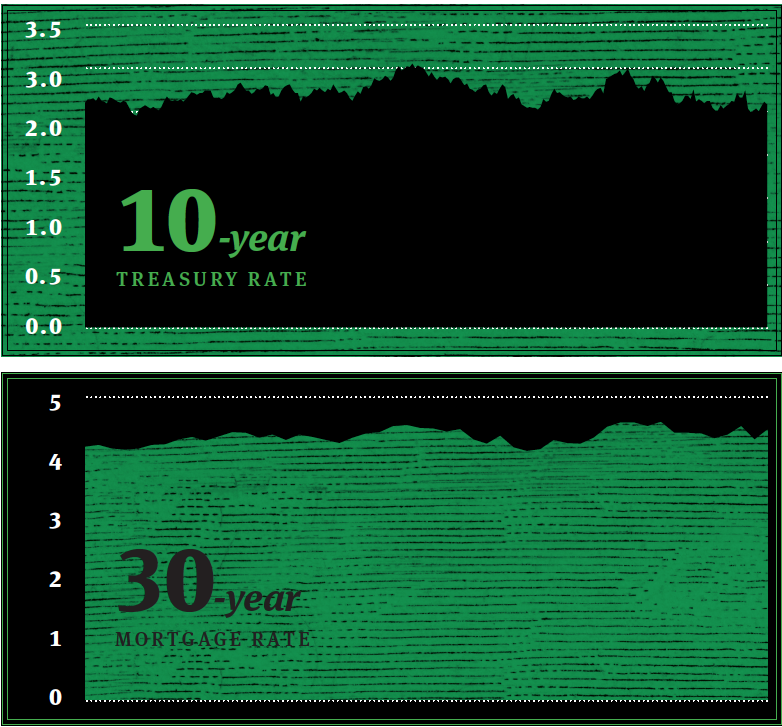The clarion call for most mortgage market pundits was pretty unanimous as we headed into 2014: mortgage rates just had to rise. They had to.
The Federal Reserve was tapering off its historic support for U.S. mortgage markets, and as the Fed tapered MBS billions of dollars’ worth of supply back onto the (otherwise) free market, prices were bound to fall — leading yields to rise, meaning higher mortgage rates for everyone.
How’d that work out? Quick answer: it didn’t.
It’s now just past the midpoint of the year, and mortgage rates have consistently proven to be LOWER now than they were last year. In fact, rates have largely hovered or fallen throughout this year. According to Freddie Mac data, rates have bounced between 4.2% and 4.5% all year long thus far, and the trend, if anything, has been for rates to drop ever so slightly from their year-ago levels.
So what happened here? How could so many pundits have gotten this call so amazingly wrong?
That answer is simpler than many might think: 10-year Treasury yields haven’t gone soaring. Most mortgage rates are generally tied to Treasury rates, as investors see 10-year Treasury notes as a comparable duration instrument to most mortgages (with some spread between them, of course, as most mortgages aren’t entirely risk-free).
With yields on the 10-year T-bill stuck in a falling trend for much of 2014, mortgage rates haven’t had much impetus to start rising, either — and this comes despite plenty of industry hand-wringing over the end of the Federal Reserve’s asset purchase program, which affects both MBS directly (via outright RMBS purchases) and indirectly (via Treasury purchases).

Treasurys have benefited from declining issuance and the basic economic concept of scarcity — fewer Treasurys available means higher prices for the notes that do exist, which has kept a lid on yields (and mortgage rates).
Net issuance of Treasurys has declined from $1.58 trillion in 2010 to $773 billion in 2013, and is expected to fall further to $640 billion for the 2014 fiscal year, according to estimates from the Congressional Budget Office. The CBO estimates net Treasury issuance will also continue to fall in 2015, to just $558 billion — or roughly a third of the levels booked in 2010.
The market’s ability to price in future issuance expectations is part of the mechanism that has helped keep mortgage rates down in 2014 thus far.
EXPECTING THE UNEXPECTED: THE EFFECT OF MIDTERM ELECTIONS
Amazingly enough, Treasury yields may be set to fall even further in the months ahead — which would likely translate to mortgage rates continuing to fall, or at least staying range-bound at their current levels for some time to come.
It’s a scenario few seem to be thinking about right now, but it could be a reality later this year depending on the outcome of the upcoming U.S. midterm elections in November.
Robbert van Batenburg, lead analyst at Societe Generale’s Newedge, recently opined, “Republicans have their best chance in at least two decades to retake the Senate, and thereby control Congress.”
Here’s how. As is stands right now, the GOP owns a 233-199 majority in the House but is a 45-55 minority in the Senate. 33 of 100 Senate seats and all House seats are up for election.
As Batenburg notes, gerrymandering will likely lead Republicans to retain control of the House during midterms this year — and the GOP then only needs to flip six seats in the Senate to regain full control of Congress.
Given President Obama’s plummeting approval ratings, the GOP may have its best shot in some time. Gallup’s most recent poll data shows the President’s approval rate at 41% — just one percentage point above his all-time low — as a burgeoning crisis in Iraq is taking its toll on the administration.
The GOP reeling all of Congress back into its grasp, were it to happen, could have a dramatic impact on Treasury markets — and by extension, U.S. mortgage markets.
In February, Congress avoided a contentious debt ceiling debate by suspending the debt ceiling until March 15, 2015. You can bet every elephant on the planet that if the GOP regains control of Congress this November, they’ll use that looming deadline to demand — and, thanks to their majority in both upper and lower Houses, force through — additional spending cuts.
SocGen’s van Batenburg believes these cuts will further constrict Treasury issuance — even further than current projections already priced into the market — driving the 10-year yield even lower than it already is.
And, most likely, bringing mortgage rates down with it.
“[The current CBO Treasury issuance] estimates do not even assume additional spending cuts, imposed by a Republican-led Congress and assume an overly aggressive $35 billion in interest payments to finance the debt,” van Batenburg wrote in a June letter.
“We believe that the confluence of lower net Treasuries issuance and lower than expected fiscal spending, which will weigh on GDP growth, should benefit Treasuries and drive yields lower.”
If Republicans fail to swing the Senate in their favor during the November midterms, it’s entirely possible that the pundits that were forecasting rising mortgage rates may finally be proven right — just one year later than planned.
A contentious and protracted fight over the debt ceiling (or worse, a government shutdown; or even worse, a technical default by the U.S. government) runs the real risk of hurting demand for Treasurys, which would send 10-year yields higher, likely taking mortgage rates with them.
All of which means there is still a considerable amount of uncertainty in the bond markets — and mortgage markets.
For example, the Iowa Electronic Mortgage Markets — a prediction marketplace for who will control Congress this November — have pegged the probability that control of the Senate goes to the GOP at 58% in trades when this story was written. Which is a better than average chance, but not by much, and the outlook can change dramatically between now and November.
Regardless, mortgage market participants would be well counseled to be paying close attention to the Senate races as the midterm election season gears up.
The outcome seems likely to affect mortgage rates in either direction, and perhaps significantly.




